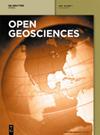无人机集群下基于改进深度学习的超深信道沙体目标识别方法
IF 1.3
4区 地球科学
Q3 GEOSCIENCES, MULTIDISCIPLINARY
引用次数: 0
摘要
河沙体具有复杂多变的特征和分布。为了提高目标识别的精度和效率,本研究提出了无人机集群下改进深度学习的超深河沙体目标识别方法。通过构建无人机群协同目标分配模型,确保超深大面积河沙体目标的采集。利用梯度直方图提取超深河沙体的图像特征,增强超深河沙体的目标图像。通过引入双向循环神经网络(RNN),构建双向长短期记忆(Bi-LSTM)网络模型,提高深度学习能力。利用 Bi-LSTM 神经网络构建超深河沙体的目标识别模型,并完成目标识别。实验结果表明,该方法能完整提取目标边缘并准确识别图像边缘,不同模糊度下的平均识别准确率高于 95。实验证明,该方法在沙体特征提取和分类方面具有较高的准确率,在河道沙体目标识别方面具有很大的应用潜力。本文章由计算机程序翻译,如有差异,请以英文原文为准。
Ultra-deep channel sand body target recognition method based on improved deep learning under UAV cluster
River sand bodies have complex and changeable characteristics and distribution. In order to improve the accuracy and efficiency of target recognition, this study proposes a target recognition method of ultra-deep river sand bodies with improved deep learning under unmanned aerial vehicle (UAV) cluster. By constructing the cooperative target allocation model of UAV group, it is ensured that the targets of ultra-deep and large-area river sand bodies are collected. The gradient histogram is used to extract the image characteristics of ultra-deep river sand body and enhance the target image of ultra-deep river sand body. Bi-directional long short-term memory (Bi-LSTM) network model is constructed by introducing bidirectional recurrent neural network (RNN) to improve deep learning. Bi-LSTM neural network is used to construct the target recognition model of ultra-deep river sand body and complete the target recognition. The experimental results show that this method can extract the target edge completely and recognize the image edge accurately, and the average recognition accuracy under different ambiguities is higher than 95. It is proved that this method has high accuracy in sand body feature extraction and classification and has great application potential in river sand body target recognition.
求助全文
通过发布文献求助,成功后即可免费获取论文全文。
去求助
来源期刊

Open Geosciences
GEOSCIENCES, MULTIDISCIPLINARY-
CiteScore
3.10
自引率
10.00%
发文量
63
审稿时长
15 weeks
期刊介绍:
Open Geosciences (formerly Central European Journal of Geosciences - CEJG) is an open access, peer-reviewed journal publishing original research results from all fields of Earth Sciences such as: Atmospheric Sciences, Geology, Geophysics, Geography, Oceanography and Hydrology, Glaciology, Speleology, Volcanology, Soil Science, Palaeoecology, Geotourism, Geoinformatics, Geostatistics.
 求助内容:
求助内容: 应助结果提醒方式:
应助结果提醒方式:


